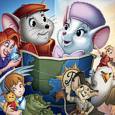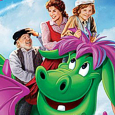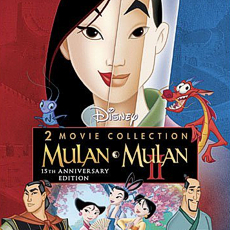Walt Disney Feature Animation (June 22 1977 and November 16 1990), Walt Disney Home Entertainment (August 21 2012), Blu-ray and two DVDs, 78 mins each plus supplements, 1080p high-definition 1.66:1 widescreen, DTS-HD Master Audio 5.1, Rated G, Retail: $39.99
Storyboard:
Set in the bustling city of New York, as well as the backwater swamps of Devil’s Bayou, The Rescuers introduces us to two courageous little mice, Bernard and Miss Bianca. Bianca is an agent for The Rescue Aid Society, a secret rodent organization that helps those bigger than themselves out of danger. When a message in a bottle is found, Bianca volunteers to go and help the sender, a young girl named Penny, on the basis that janitor Bernard is made her co-agent, something that he, being fond of Bianca, is more than happy to agree with! Soon they’re off on the back of Orville the airline albatross, soaring towards the Bayou where Penny is being held captive by the twisted, and not altogether sane, Madame Medusa. She has Penny locked up so as to use the girl to fit down a teeny-sized cave and retrieve the legendary Devil’s Eye – the biggest diamond in the world! The two mice arrive in time to help Penny and find the diamond, but Medusa and her sneaky assistant Snoops prove that they’ll stop at nothing in order to keep the diamond from escaping their clutches…

Becoming the first official Disney animated sequel, The Rescuers Down Under follows our intrepid heroes to the Australian Outback when young boy Cody finds himself in peril after discovering the illegal traps set by the dangerous poacher Percival McLeach, who locks the boy up in one of his cages. This leaves one little mouse – the only one to have seen the proceedings – to contact the RAS, where Bernard has been promoted to top agent and still burns a candle for Miss Bianca, even though his nerves mean he can never quite pluck up the courage to pop the big question. Just as he’s about to announce his proposal and reveal the ring, the pair are whisked off to Albatross Air where, with Orville on another assignment, the mice call on the services of…who else…Orville’s brother Wilbur! As terrified as ever of unstable air travel, Bernard buckles in for another flight (a stand-out CG-enhanced sequence that flies them from the New York skyline to the wild Outback). Here, they team up with Jake, a local “kangaroo-mouse Dundee”, to track down Cody and Marahute, the great golden eagle that Cody has befriended and who has fallen under the greedy sights of McLeach…
The Sweatbox Review:
The Rescuers, as with so many of the “middle-Disney” pictures that came right in the midst of the period between Walt’s passing and the management takeover of 1984, is a strange title to try and pigeonhole in the overall Disney scheme of things, even if as the very first of these films I ever saw in a movie theater it has remained a nostalgic favorite of mine over the years. It was always very hard to see: traditionally in home video terms at least, the film has often been one of the last ones to be announced or released on any format, coming late in the game on VHS, LaserDisc and DVD even though it was a big hit back in original release. Why The Rescuers has always been “late to the ball” is unknown, but this great little film really does deserve to get some better recognition, especially as it came at a time when the animation division needed a hit and was luckily rewarded with this blockbuster.
By the time of the film’s release in 1977, the Disney Studio had lost its way a little, trying to come up with projects that Walt might have made. A fine enough thought, but Walt was always progressing and changing with the market – and more often than not actually leading the market! The creation of the adult-orientated Touchstone Films in 1983 would go some way to restoring box office glory to the Studio, but in the 1970s, everything was either kids-in-trouble adventures or fantasy-comedy territory, something that the Studio was known for, but also ridiculed. The live-action films from this time (and I do count myself as a big fan of most) were by-the-numbers comedies, with not-so-special effects, and felt like a continuation of the 60s family films that the company produced, though with a new “funky” sensibility in their bass-guitar and Hammond organ-led music scores.
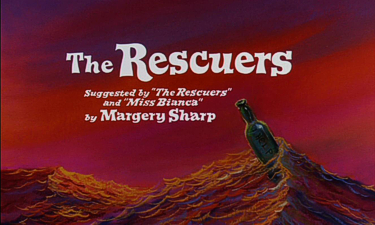
In the animation department, the first film to go into production after Walt’s last, The Jungle Book, was Ken Anderson’s The AristoCats (actually being concurrently released with The Rescuers on Blu-ray), which Anderson had proposed to Walt and for which he was personally given the go-ahead. The film proved a hit (especially in France) and main vocal talent Phil Harris was brought back for a third time (after Jungle Book) to reprise his “big bear” role as Little John in the unit’s next feature Robin Hood, the story of which had itself already been tackled by Walt in his 1950s British-shot live-action feature starring Richard Todd. The clever and intriguing switch here was that the legend of the Merry Men would be depicted by animals, a “Merry Men-agerie” as the posters proclaimed). Robin Hood was a fun knockabout comedy, with moments of light pathos, but more often than not, the feeling of an old English pantomime. A bit too freewheeling perhaps, Hood also suffered from not having any through-story, with the result that the plot felt very episodic and the film, while enjoyable enough and still a favorite of many, ultimately coming off as unsubstantial.
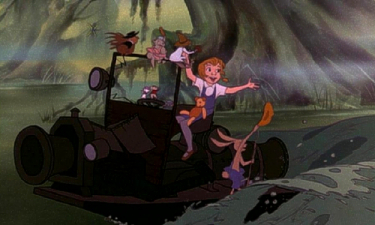
Perhaps feeling dried up, the Studio began its new animation training program, which brought in a new generation of artists full of new ideas. After a few quiet years, the Studio bounced back in 1977 with three features: The Many Adventures Of Winnie The Pooh, a compendium of the three Pooh featurettes that had originally been intended as a feature; Pete’s Dragon, another live-action/animation musical combination that, as with the Studio’s Bedknobs And Broomsticks, had a less than stellar post-Mary Poppins reception at the box office; and The Rescuers. The Pooh film had been a moderate success, bringing in a new audience for A.A. Milne’s characters, but Dragon had been no less Candle In The Water as pretty much dead in it, and the animators were still under scrutiny. Returning to animated mice (always lucky for the Disney company!) their new film had to live up to high expectations. Thanks to a tight storyline, contemporary setting and wide scope the aptly named The Rescuers delivered and put the company back on track.
In a day and age when many new animated films proudly claim that they don’t have any songs within the score to slow things down, many forget that The Rescuers pioneered the use of songs on the soundtrack as opposed to having the characters actually mouthing the words. Another recently broken “rule”, that animated films don’t usually have their voice casts revealed in advertising, was also abandoned here, with original release posters for the film proudly announcing it’s then-hot cast of Bob Newhart as Bernard and Eva Gabor (playing another slinky Disney character after Duchess in The AristoCats) as Bianca. The voice cast is top-notch and all the performers perfectly fit their roles. Equally as good as the leads is Geraldine Page as Medusa, putting her all into the character and distinguishing her enough from the similar Cruella De Vil, with whom she could be related (early concepts show that Cruella was in fact potentially down to “star” as the villainess of the film).
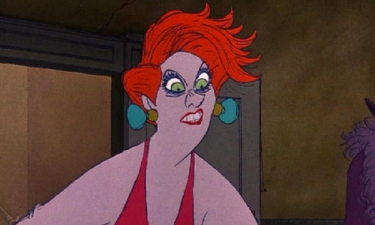
Many critics’ views against The Rescuers are aimed at the animation in the film. Although a smash hit, The Rescuers was produced on an extremely tight budget, something that might have damaged the timeless nature of the production and possibly dates the picture. Certainly during production the artists were complaining that corners were being cut: it was a supervisor that advised young animator Don Bluth not to bother coloring the whites of Bernard’s eyes that finally tipped the scales and contributed to his walkout along with several other new talents. But in fact The Rescuers actually features some outstanding scenes, especially before the advent of computer assisted production. It has a very dramatic look to it, particularly in the swamp moments with Evinrude trying to outrun Medusa’s evil crocs Brutus and Nero, thanks to Woolie Reitherman’s direction, here sharing with Art Stevens and John Lounsbery, and Artie Butler’s careful and almost live-action use of music, which never “Mickey Mouses” the action.

The entire film looks and feels quite dark at times, and there are some terrific angles used to emphasize and successfully depict the size and scale of having two little mice play against human figures. There are also some bold choices that wouldn’t get past the over cautious at Disney nowadays, not least the child kidnap plot and Medusa’s forcing Penny into the cave (“You get down there and find the big diamond or you’ll never see your Teddy again!”). And can you see the scene where Medusa actually aims and fires her shotgun at the young girl making it into a modern Disney film? Even Spielberg shied away from that in his revised edition of ET (even if the guns will be restored for that film’s Blu-ray debut later this year). This is however what makes the film work: that Penny is an orphan sets her up as an even more sorrowful character that needs rescuing in more ways than one, while the lengths that Medusa will go to places her in real danger. As an audience member, one also has to wonder what will become of Penny once Medusa has what she wants.
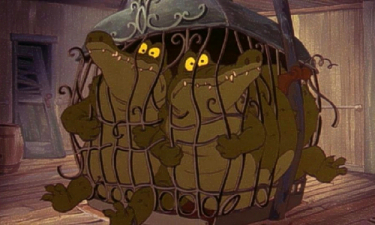
On the flipside, there are several heart warming scenes, such as when the two brave mice meet Rufus the orphanage cat, and the Oscar-nominated Someone’s Waiting For You sequence, as well as the pure excitement and suspense of the ride through the swamp with Evinrude, and Bianca’s own rescue from the water. The choice of the voice cast, again as with The Jungle Book and Robin Hood chosen for their personalities as well as their acting ability, helps give the feeling of truly dimensional characters that need no introduction: we know exactly who they are when we first meet them, a fact that was noticed by the critics of the time of the film’s initial release. The little touches in the backgrounds are fun too, such as the normal-sized everyday human objects that have been redesigned and implemented in the mouse world (the Mickey Mouse watch used as a clock on the wall of the Rescue Aid Society, which resides in the basement of the United Nations, for instance). And although the film makes use of the Xerox process, there’s an attempt to return to colored ink lines on the characters that does bring the quality level of the animation – and its delicate, fluid quality is never in doubt – back up in other ways.

The Rescuers is, at the end of the day, a very good-looking film, especially in terms of the some solid color concepts going on in the backgrounds, and it is clear that attempts to get away from the stylised layouts of the 1960s were being made. Some are great and pre-empt the use of CGI for various props, such as the escalator that the mice take to the top of the airport lounge, or the light changes underneath the helipad, while others (the static sea during the “journey” sequence) may seem flat to first timers now used to ever-improving CG water effects. These are among some of the other subliminal cost cuts that will stand out to long-time Disney fans: Medusa’s getaway in her car will again hark back to Cruella’s chasing the puppies, and some recycling of material from Bambi may seem familiar, but just as interesting is the fact that this is the real transitional film that bridges the gap between Walt’s original “Nine Old Men” and the new generation of artists, among them Glen Keane, Ron Clements, Andy Gaskill, and the Bluth team of Gary Goldman and John Pomeroy, and it’s great to be able to see how far these talents – in particular superstar animator Keane – would come on by the time of the 1990 sequel.
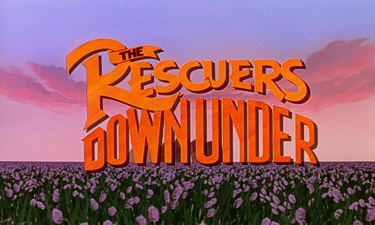
The Rescuers Down Under, then, makes for an excellent contrast in these respects, allowing us to compare the same characters and artists’ work from the pre-digital days to how the same kind of film would essentially be made today (if anything, the original film has only “dated” in its production process, the sequel still feels like it could have been released in the last year). The first movie could arguably be seen as being the last in the original line up of Disney films that began with Snow White And The Seven Dwarfs 40 years earlier, with the films that just preceded it all having had Walt’s thumbprints on them to some degree. The Rescuers marked that point when many of the old guard had retired and the new blood set out to prove what they could do with a brand new story, their subsequent films building on this initial success to develop the next generation of artists that would hone their talents with such as The Fox And The Hound (1981) and Mickey’s Christmas Carol (1983).
The introduction of new management and notorious disaster of The Black Cauldron in 1984 and ’85 set the Studio on a new course to try and return to the traditional values of Disney’s past, and the very reason many of the artists had joined the Studio in the first place. The “animation renaissance” of the late 80s through the mid 90s was very much due to these creative people, before they somewhat became slaves to their own success. Nowadays, each animated feature (from any studio) must “top” the last one, meaning costs go up while the films become more “safe” and formulaic, but back then the Studio simply continued to ride the wave of perfectly sharpened storytelling coupled with technical innovation – exactly the values that Walt pioneered and that would find themselves distilled through the Disney process to the eventual Pixar people.
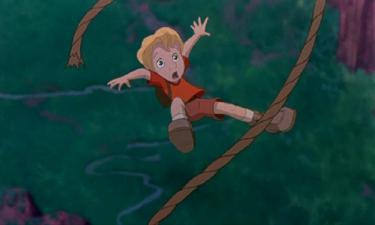
The big technological breakthrough at the Studio was the development, with Pixar, of the Computer Assisted Production System, a proprietary process that meant the animators’ drawings could be scanned, inked, painted and rendered out within the computer, combined with traditionally painted backgrounds or computer animated environments. The 1988 experiments on Who Framed Roger Rabbit proved that perspective animation allowed for a great deal more depth in these regards, and the CAPS system had been pressed into service for two scenes in the Studio’s previous film The Little Mermaid, but now it was time to merge the two together and it was reasoned that, with the majority of the budget going on a technical process that would benefit future features, it was deemed that a project that could cushion these costs would be preferable.
Long before the series of direct-to-video “cheapquels” began to emerge, the idea of a Rescuers sequel – still the only narrative follow-up to be animated by Feature Animation – was pitched. The Studio was trying to keep costs down after the huge outlays for Roger Rabbit and Mermaid, and out of all the films in Disney’s library, perhaps none was more suitable for the follow up treatment than The Rescuers. The setting was contemporary, based on a series of books by Margery Sharp, and leads Bernard and Miss Bianca naturally lent themselves to continuing adventures. More importantly, the original release had not only resulted in Disney’s highest grossing animated feature of the time, and with an audience already established, but a lot of the pre-production ground had already been covered too, in terms of characters having already been designed and concepts already developed.
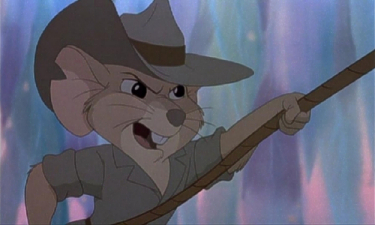
But what began as an idea for a fairly inexpensive movie actually turned out far more costly due to the experiments with the new CAPS process, the technique that had been discovered and explored in Roger Rabbit and would find its apex in the ballroom sequence of the Studio’s next film, Beauty And The Beast. While CAPS allowed for the combining of hand-drawn and computer animation, meaning that the artists could move around their environments, it also meant that the animators had to take more time and care in able to be more precise with their drawings. Added to all this was the way The Rescuers Down Under was produced, becoming the first Disney animation film of recent times to be entirely colored and rendered within the computer and scanned back out to film for theatrical exhibition. This opened up the possibilities of the animation medium expansively, allowing for greater colors, depth and involvement for the audience.
The film was sold on posters as “the first animated action-adventure movie”, and although of course this isn’t strictly true (well, maybe it was Disney’s first action movie though even that is debatable), the publicists were getting at the fact that this was a much more “edgier” approach, with no songs, but plenty of scrapes and near-misses – think of a tooned-up Jerry Bruckheimer film! In a featurette made during the making of the film back in 1990, Glen Keane described the movie as “probably the most technically advanced feature we’ve ever done” and it really does still hold up today. Some of the computer-generated animation is simply amazing (standouts are the amazing flight sequence during which Cody and the golden eagle Marahute bond, expertly handled by Keane, and the SOS message being sent to the RAS, both terrifically scored by Bruce Broughton), and seeing it again on a big screen with the clarity of HD is breathtaking.
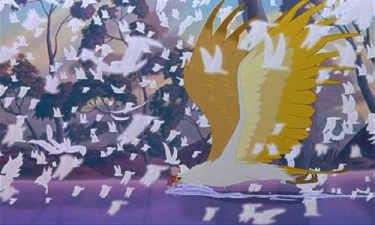
It’s again interesting to compare the animation styles between both pictures right next to each other, especially as some of the crew names appear, albeit in some different capacities, on both. The Rescuers was one of the last features produced in the Xerox “pencil line” way, and Down Under the first product of computer ink and paint, an artistically successful triumph that brings a jaw-dropping detail to environments, vehicles and props. On a smaller scale, the delicate character animation is appealing: Bernard is still the same character but perhaps loses a bit of the mousey-ness that the scratchier Xerox look provided. He even gets a slight revision so that his eyes are white, or at least subtlety a lighter shade of gray, and Bianca now looks radiant with a subtle touch of rouge. Both our mouse heroes are still written as the characters we loved in the original The Rescuers: Newhart and Gabor return to Bernard and Bianca respectively for their trip Down Under, and there is a nice gentle interplay between them that can only come from such experienced players, both bringing a sense of backstory with them in the voices that doesn’t even need describing in the script.
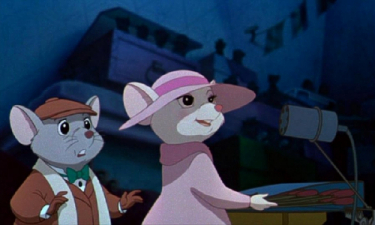
What is also nice is that one doesn’t have to have seen the original film to keep up with the in-jokes and familiar scenes and characters, although that’s not so much of an issue in a double feature set. Disney was mindful that a generation had passed between the two films’ releases and were careful not to let too much rest on the earlier film. In the end, they needn’t have worried – many of the kids who saw the 1977 movie were now parents themselves and more than enjoyed taking their kids along to see the new adventure. In the other voices, and with 1977’s Orville, Jim Jordan, having passed on, John Candy steps in as Wilbur (geddit?), giving it all he’s got and being his usual loud but loveable self in his expanded Albatross Air role, often providing the funniest lines (including an at-the-time very topical but even now peculiarly un-dated “Cowabunga!”) and finding himself the butt of a couple of situations. Although he’s a secondary character, Candy makes sure you don’t forget him, and his talent is still sorely missed today.

Released soon after Disney’s own DuckTales adventure movie spin-off from the Studio’s phenomenally popular TV show, The Rescuers Down Under was certainly not as successful as some would have hoped and couldn’t beat the figures for the first film over a decade before even with the latest Mickey Mouse comeback featurette, The Prince And The Pauper, presented as part of the double-bill program. There are perhaps many reasons for this, though most of them point towards the marketing of the movie: when Jeffrey Katzenberg heard that the first weekend’s takings had barely made a dent in the film’s costs he essentially pulled the film from enough screens so as to dampen any further distribution hopes – a highly understandable business decision but one that unfairly quashed the delights of seeing such great artistic work from the new generation animators coming full circle on their beginnings at the Studio and hinting at what creative and technical marvels were about to come flooding out.
Despite the cool theatrical reaction, The Rescuers Down Under really is a very underrated film. All the characters have a great deal of depth to them, and in McLeach we get the same kind of “real-life” villain that Medusa was. Voiced by veteran actor George C. Scott, McLeach might not be as totally rounded as Medusa since he operates with a one-track mind’s motive, but Scott brings him a cool and calculating menace boiling beneath the surface, letting slip that he really could actually turn out to be very nasty indeed. Adam Ryen’s Cody is only slightly less successful, mainly due to his Americanized Australian accent. I was quite surprised to find that he was actually of Scandinavian descent and had only been in America five years previous to recording his lines for Down Under. As a character, Cody works just right. He’s not just a replacement for Penny from the original; he gets stuck in and tries to make things happen, and we can easily believe his friendship with Marahute due to the “acting” from both characters.
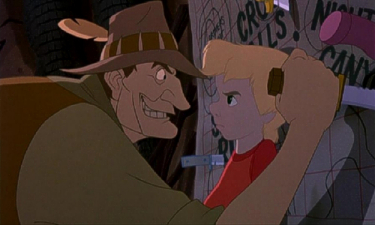
Bernard and Bianca’s second outing did eventually find an appreciative audience on home video, where the release of the first film had increased interest in their continuing adventures, but perhaps its standing as a supposed commercial failure is why the Studio has never committed to any further films. With the advent of the Disney’s made for video features, I never worked out why the heck the Studio didn’t make more!? The characters lend themselves to countless adventures, the stories are there and the development all done: the idea of the video sequels was that they had low start up costs and could bring in quick revenue while providing a continuation of the Studio’s classic stories and characters, and if ever there was a series – a franchise even – in Disney’s animated line-up that could be legitimately exploited in this way then it is The Rescuers (and this given that even The AristoCats, of all things, once had such a sequel developed).
Sadly, it seems the time for that has now passed, but even so we still have two terrific films to look back on, both of which remain largely and unfairly overlooked. Celebrating its 35th anniversary, it’s lovely to see the original The Rescuers back on screens, and if that is an excuse for its sequel to make it to Blu-ray as well, then I’m all for it. Hopefully this disc release won’t get lost among the heap of other titles coming out on the same date: it really is the best of the bunch, combining straightforward storytelling, groundbreaking techniques and enjoyably animated adventure that will thrill you and make you laugh. Both The Rescuers and The Rescuers Down Under are complete delights – perfect family fare with enough invention to delight anyone in the room.
Is This Thing Loaded?
As probably the first of Disney’s animated features that I saw in a movie theatre, The Rescuers has always been high in my list of favorites, not only for that reason but because the film is a unique one in the Disney catalog for being pretty much a straight thriller and not the kind of cutesy singing animal movie that had come before or since. So it’s always been frustrating that, as a big hit at the time, the Studio declined to issue the original film on video for many years, perhaps another theatrical reissue beforehand (The Rescuers was reissued once, with Mickey’s Christmas Carol in 1983). It finally did arrive, on VHS and LaserDisc in the run up to the sequel’s theatrical release, but in a full-frame edition only.
In the late 1990s the film came to LaserDisc again, in a lovely new widescreen print that preserved the original negative ratio of 1.66:1, but fans had to be quick to snap it up when it transpired that a pesky video technician, presumably bored with his quality control job at the Mouse House (a situation I find impossible to believe!) had inserted a nude image of a topless woman – by turns believed to be a photograph or a reproduction of painted art – that could be glimpsed for two frames as Bernard and Bianca zoom through New York as Orville makes his take-off. Not believed to have been an in-joke from when the film was originally released in 1977, Disney recalled over three million copies and again the title languished in the vault.
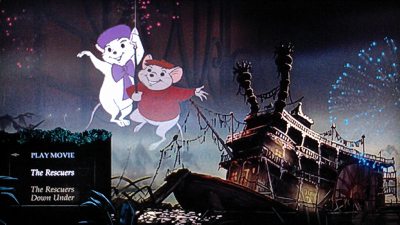
After the Studio’s initial Limited Issue and Gold Collection DVD releases came and went without mention of The Rescuers (although its sequel did get a Gold release), it finally arrived on digital disc in 2003, essentially using the same transfer as the previous LD and again presenting the film in its true 1.66:1 ratio. The release wasn’t designated as a Special Edition and its smattering of extras was minimal and mostly mediocre. That the same bunch of material is again present here – except for a fifteen page Scrapbook – is expected but disappointing in lieu of a nice new serving of supplements, but there are still one or two pleasant surprises in the mix.
Disney’s concurrent August 21 2012 catalog titles have all include a new high-definition featurette for each new release – a nice incentive for collectors – and the first option from the Bonus Features menu here (a menu that focuses specifically on the first film, presumably using the same elements as its individual release in Europe, where the second film gets its own disc) is to meet original Rescuers animator Ron Clements, of course now a director stretching from The Little Mermaid to The Princess And The Frog, who reveals all about the film’s early development and, in particular, Peopleitis: The Deleted Song (4:41).
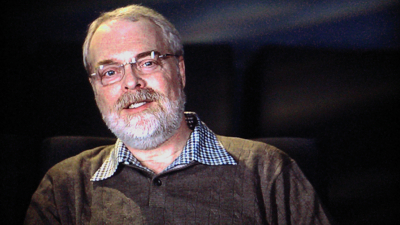
Even from this brief look into an abandoned sequence one can guess what kind of film The Rescuers was originally intended to be: here, when the mice take their shortcut through the Zoo, they were to have met a friendly bear, voiced by Louis Prima, who elaborated through a jazzy song about meeting Penny and how friendly she was to the animals (the song also has satirical fun with the animals’ view of the humans who come to watch them). Dating from as way back as 1973, it’s clear that early treatments were perhaps more akin to the kind of light-hearted musicals the Studio’s last three films had been, before thankfully more development work (maybe from the younger artists coming aboard?) moved the film in another direction.
Eventually being released five years later, in a prolific year which also saw the very cute The Many Adventures Of Winnie The Pooh and traditional musical Pete’s Dragon, it’s hard to think of a film more different than The Rescuers could have been to those releases, and just as hard to picture it as the kind of film it might have been had it come just a few years earlier. But the harder edged cinema of the early 1970s had been felt in the live-action division of the Studio (in such pictures as John Hough’s Witch Mountain thrillers) and, with the likes of Jaws and Taxi Driver on screens, it seems the crew realised it was time for a change from the Jungle Book, AristoCats and Robin Hood formula.
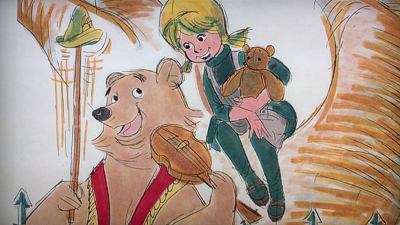
The Rescuers’ resulting box-office success proved the changes were for the better, and the film is still a unique one in the Disney pantheon for being what is ostensibly a song-less animated thriller (the sequel could be better explained as being an adventure). Having the likes of Prima performing the kind of song, by The AristoCats’ Floyd Huddleston and Al Rynker, that could only be described as a throwback to an older Disney style certainly wouldn’t have fit into the film The Rescuers turned out to be, but it’s always cool to experience even a little of a movie’s development and have a chance to see concept art and, especially, hear abandoned songs, and the package as a whole offers a little more of this kind of material (see below).
Showcasing the Oscar-nominated song of the three that did make it into the film, a Someone’s Waiting For You Sing-Along doesn’t, for a change, simply select that section of the disc and switch the subtitle track on, but plays an alternate dedicated clip – still of the same sequence from the film – with its subtly different studio recording version, again sung by Shelby Flint. It’s no great shakes as an extra, ultimately, but nice to see Disney remaster this from the new HD transfer as opposed to reusing the age-old battered and beaten up clip on the previous DVD.
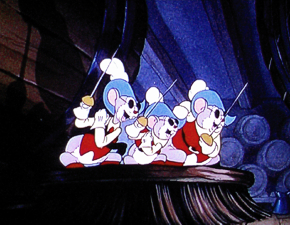
More substantial, though no less inconsequential, is the return of a cartoon that seems to be included only as it stars mice, three to be exact, in the 1936 Silly Symphony Three Blind Mousketeers. Again from the previous DVD, I’ve seen this short so many times that I was weary of sitting through it yet again, but a new AVC transfer offers a fresh look even if the transfer looks interlaced to me and the print still isn’t as clean as other recently remastered cartoons that have been turning up on other Disney BDs. The exquisitely detailed cartoon, running almost ten minutes, follows the three blind mousketeers’ attempts to outwit a Black Pete-type and grab some of his food, but packs in a great deal of fun and some terrific light and shadow effects.
Half expected due to being on the DVD, but not quite as enjoyable as the cartoon, the real surprise in the inclusion of the half-hour True Life Adventure film Water Birds is that this 1952 entry in the series is now presented in excellent, if not stunning, high-definition rather then the college campus 16mm copy dragged through one too many wildlife classes that appeared previously. Narrated by Winston Hibler, the film has a nice segue from an animated paintbrush to the live-action footage, but after a while the dry voiceover makes it a bit of a chore to sit through and it simply isn’t as lively or dryly humorous as the other Adventures that came to DVD in a wonderful limited edition series of their own.
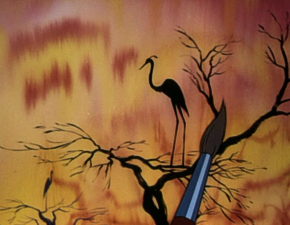
The footage, photographed by 16 cameramen, is certainly amazing, especially considering that these films pioneered the stunning “life on Earth” documentaries of today: the True Life Adventures opened up a whole new world of entertainment – our own – and were brought to life through the magic of motion pictures by Walt’s ability to tell a good story. This is true life the Disney way although it does not shy away from the animals’ natural instinct and feeding habits. Hibler’s narration fashions together a plot of sorts, but it’s Paul Smith’s vibrant and energetic musical score (ending with a bombastic rendition of Listz’s Hungarian Rhapsody, a cartoon favorite) that just about keeps things lively and entertaining enough.
Ridiculously losing the fifteen pages of Scrapbook imagery that featured very interesting alternate production concepts, character development that included an early Cruella-wearing-crocskin-coat picture, and production and publicity art (one of which refers to the film as The Rescuers At Devil’s Bayou), as well as dropping a couple of more slender offerings (a set-top game and brief generic spot looking at Disney’s villains), that’s it for the slim helping of The Rescuers “supplements”, leaving things to the 10½ minute The Making Of The Rescuers Down Under featurette to provide at least a little significant amount of behind-the-scenes material pertaining to the disc’s actual main features.
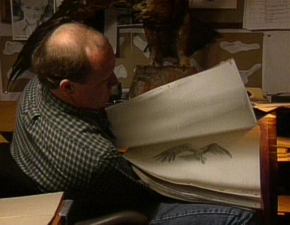
Here the onus is on then-Disney Animation head Thomas Schumacher sprouting on various banalities about the upcoming movie, the most inane being, “We knew Bernard and Bianca would come back in this movie because it’s a film about them” which, after listening back to this statement several times, I still can’t put my finger on what he’s trying to say. There’s a little speak about the original Rescuers, which seemed to still be revered at that point, and a chance to see the animators at work, including Marahute’s Keane who, for the first and only time, is less his usually sincere self here and seems to come across more arrogantly than I’ve ever seen before or since, perhaps the result of success with Ariel in The Little Mermaid or because of the star animator salaries that were starting to creep in. There’s more electronic press kit material like this that could have been included, but this is better than nothing and is “new” to this release.
From The Rescuers Down Under’s previous DVD, a theatrical trailer is missing when the previews for both films would have been welcome, if token, extras. On the disc as is, the cartoon and the True Life Adventure seem only to have been included due to the similarities in the types of animal seen in the films themselves, but real disappointment is in the dropped Rescuers Scrapbook, which at least offered some insight into the making of the film often with previously unseen images. You’d have thought these extras might have been retained on the two FastPlay enabled enclosed DVDs for each movie, but the two discs are sadly of the freshly re-authored variety, offer practically nothing.
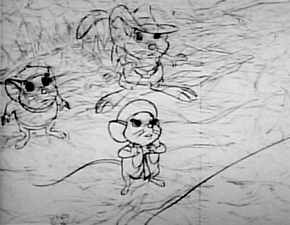
The Silly Symphony cartoon, True Life Adventure and Sing-Along make repeat appearances on The Rescuers, while The Making Of clip pops up again for the Down Under DVD. Across all three discs, Disney’s current roster of Sneak Peeks autoplay (or are selectable from their own menu option): here the likes of Cinderella’s Diamond Edition, Finding Nemo’s 3D return to theaters, Tinker Bell’s Secret Of The Wings, The AristoCats, Beverly Hills Chihuahua 3 and Planes are previewed among other Disney promos.
Case Study:
For a double-feature set, The Rescuers and The Rescuers Down Under actually gets a really nice sleeve treatment, following Disney’s usual practice of splitting the front artwork into two halves for each title. Bernard and Bianca sit front and center on the glossy, embossed slipcover, with Medusa, Penny, Nero and Brutus on the left hand side, and Cody, Marahute and Jake the kangaroo mouse on the right. Also on the cover is Orville, or is that Wilbur? Despite being on The Rescuers’s left hand side, it sure looks like the sequel’s albatross takes the honors here.
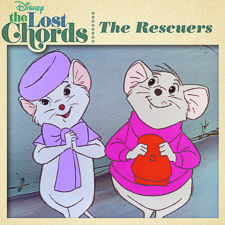 Inside there’s the Movie Rewards code, which also unlocks a pretty cool download for The Lost Chords: The Rescuers [right], a digital album of eight demo tracks for songs, presumably from the earlier, jazzier version of The Rescuers, that didn’t make it into the final film. Peopleitis can again be heard in demo form and by Louis Prima, along with three other tracks in demo and Prima versions.
Inside there’s the Movie Rewards code, which also unlocks a pretty cool download for The Lost Chords: The Rescuers [right], a digital album of eight demo tracks for songs, presumably from the earlier, jazzier version of The Rescuers, that didn’t make it into the final film. Peopleitis can again be heard in demo form and by Louis Prima, along with three other tracks in demo and Prima versions.
There is a catch: to redeem the album one must cough up a nominal $4, which is quite a cheek when asking $40 for the set overall, but it’s still better than the $7 asked for without a purchase of the BD set and my guess is that Disney fans would rather have these tracks than not, and there’s a nifty digital booklet that outlines the tracks and fills in a little more production history too!
In addition, and as with all of Disney’s August 21 Blu-rays (which include Lady And The Tramp II, The Tigger Movie, Pocahontas, The AristoCats and Disneynature’s Chimpanzee), one of the two stickers on the slipcover offers $10 off the title when purchased with another concurrent release, which is good up to September 30 2012, while the demo track download is good until 2013.
Ink And Paint:
With Disney’s current trend of reformatting even their original 1.66:1 aspect titles to the more HD-friendly 1.78:1 ratio, I was a little worried that at least one or both of The Rescuers movies would also find themselves cropped a little top and bottom. There isn’t a great deal lost in filling the native 16:9 frame, but I’m more prone to letting these things slip on the Studio’s direct to video titles and I really can’t see why Disney keeps insisting on making these changes when a 1.66 frame offers more of the original negative ratio information and still fills a 16:9 display where overscan would mask any sliver of black on each left and right side. With the original film seemingly dropped in the Studio’s regard, and the sequel potentially confused with a DTV title, I was ready for the worst…but happily there’s nothing but good here!
Phew…both films retain their original and correct 1.66:1 framing, and after fairly non-exemplary DVD issues, look absolutely beautiful. The Rescuers has its Buena Vista distributor logo back in place, while Down Under now does not resemble the worn out, weeks-old multiplex print it did before. If there is a very minor disappointment it’s that Down Under is not sourced digitally, but then it may never have been mastered that way: the first CAPS feature was rendered back out to film and it was Beauty And The Beast that became the first film to become digitally mastered. In a way, this is actually preferable here, since both films, while sporting the vastly different production techniques of analog vs. digital, still retain a celluloid common bond that goes a long way to providing a core similarity between the two.
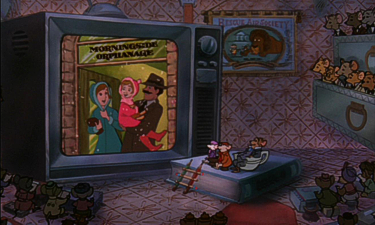
In terms of image quality itself, both films have undergone digital restorations, and rather than the gate-weaving, print-marked original DVD, The Rescuers is now solid and spotless. The same goes for Down Under, the more modern technique really helping the movie’s colors pop; the look is “hot” and you can practically feel that burn coming off the screen. While not quite as extensively digitally scrubbed as, say, the surprisingly sterile look of The AristoCats from the same era, The Rescuers retains a very light grain element in the image, and pleasingly so I felt, while any minor cel scuffs and compositing in evidence are due to the techniques employed during production. With Down Under, from the opening low-angle swoosh through the Outback and the rooftop launch in New York, to the high-flying ending, the light grain actually gives it a more “cinematic look”, creating quite the epic feel.
It’s often said in the promotional material bandied about when a film gets an extensive digital restoration that the results offer a chance to see the film “even better than when audiences saw it in original release”, or words to the effect. Well, while both these movies haven’t undergone the absolutely pristine digital cleans that the likes of Snow White and Pinocchio enjoyed, the results are not far off, with plenty of new detail apparent and the animators’ line drawings clearer than ever before. In many ways this is preferable, since The Rescuers especially hasn’t lost what made it a hand-crafted film to begin with. Both films may not reach the hypothetical “better” than audiences first saw them description, but they’re certainly the best I have ever seen them look on home video, and sure as heck look just as good as they did on opening night – and we’re talking premium showprints here!
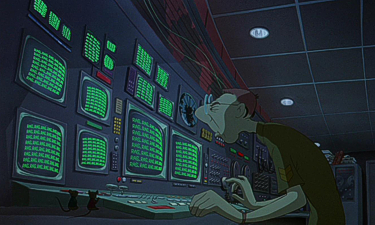
Scratch Tracks:
Given a new 5.1 mix for its previous DVD, The Rescuers didn’t really open up the soundfield too much from its original mono theatrical and LaserDisc editions. The DTS format doesn’t really do too much to change this view: dialogue, of course, remains locked to the center and sounds crisp and clear as expected, but where the track really shines is in giving a much needed bit more depth to the music, which could sound screechy and frequency-thin in places previously. Here the score feels a lot less dated in recording technology, spreading to the left and right more and just sounding more rich and breaking free from the mid-range compressed confines of the original recordings.
The Rescuers Down Under, on the other hand, has always sounded rich and full, the original 4.0 theatrical surround lending itself well to a DTS upgrade. Again the music is a strong anchor point; Broughton’s fantastically involving score, still a hard to find CD but more easily found as a digital album, absolutely pulsates through the air. The main title excites greatly and perfectly sets up the fact that this one is going to be a little different, while Cody’s eagle flight is a tour de force of all the elements: music, animation, effects, pacing and direction; one of the most all-round accomplished and exhilaratingly emotional scenes in all of Disney, magnificently on display here.
In addition to English, French and Spanish Dolby 5.1 dubs and subs are all optional.
Final Cut:
It’s fairly odd to see a film from the same era as The Rescuers, in this case the concurrently released The AristoCats, seemingly getting more attention in Disney’s latest Blu-ray round-up, when that title has traditionally always been seen as a secondary one in the Studio’s animated canon while The Rescuers was for many years an A-list feature. I can’t think what has changed this perception other than the box-office rejection of the arguably just-as-good (and certainly technically superior) sequel, which unfairly seems to have tarnished both films’ future outlook on home video.
But The Rescuers is a fairly important film in that it saved the animation division back in 1977 and, even if its sequel couldn’t live up to its success those many years later, I still think Disney missed a trick in not carving out a Rescuers franchise of video sequels or, at least, a Bernard And Bianca series of television adventures. Not every title warrants the full-on special edition treatment, but with a complex development history The Rescuers does deserve more than this, and I know there’s more on the Down Under sequel that could have also been included (how about Mickey’s Prince And The Pauper in HD, for one?).
The Rescuers Down Under is the Studio heading towards the top of their game, with all the tools at their disposal and pushing boundaries while still paying attention to details and story. As always, it’s the next generations that can make these films hits again, and I genuinely hope both films deservedly find appreciative new audiences. Out of all of Disney’s August 21 titles, it does seem that The Rescuers’ original fans are eager to share the adventures with their kids: it’s great to see this set – at the time of this review’s writing – placed so high on Amazon’s Blu-ray sales chart (at #4), just below the box-office behemoth that was The Avengers and just above the cinematic classic that is Jaws: Bernard and Bianca still, it seems, know how to keep good company!
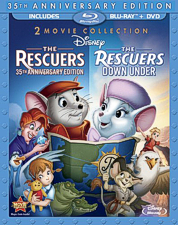 | ||
 |


